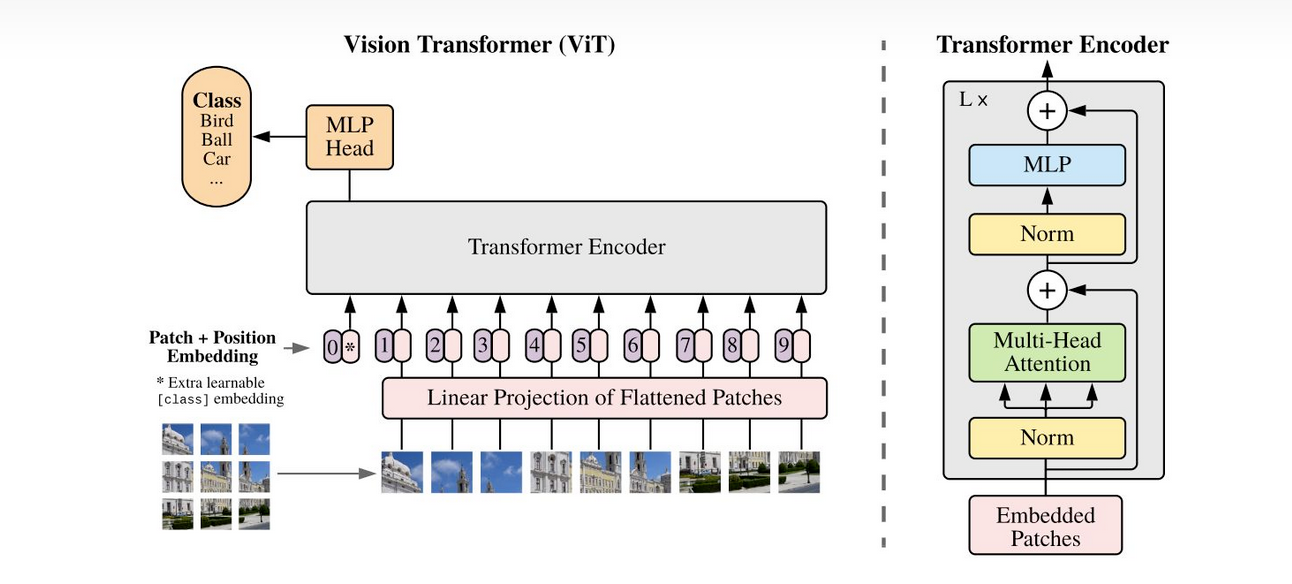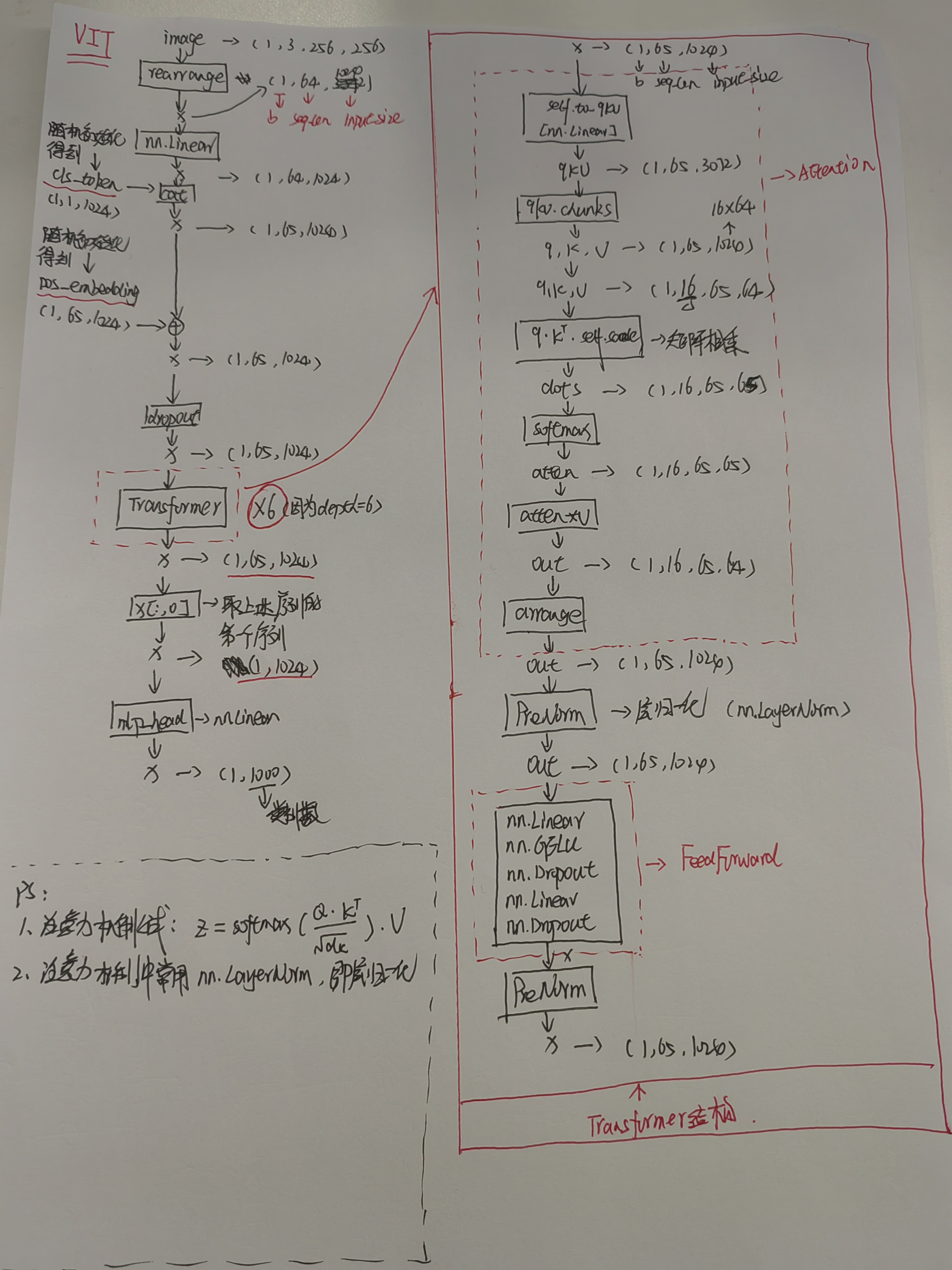vit结构如下:Transformer主要包含Attention和FeedForward

vit结构手写(对照下面代码观看):

vit实现代码如下,可对照上图理解:
import torch
from torch import nn
from einops import rearrange, repeat
from einops.layers.torch import Rearrange
# helpers
def pair(t):
return t if isinstance(t, tuple) else (t, t)
# classes
class PreNorm(nn.Module):
def __init__(self, dim, fn):
super().__init__()
self.norm = nn.LayerNorm(dim)
self.fn = fn
def forward(self, x, **kwargs):
return self.fn(self.norm(x), **kwargs)
class FeedForward(nn.Module):
def __init__(self, dim, hidden_dim, dropout = 0.):
super().__init__()
self.net = nn.Sequential(
nn.Linear(dim, hidden_dim),
nn.GELU(),
nn.Dropout(dropout),
nn.Linear(hidden_dim, dim),
nn.Dropout(dropout)
)
def forward(self, x):
return self.net(x)
class Attention(nn.Module):
def __init__(self, dim, heads = 8, dim_head = 64, dropout = 0.):
super().__init__()
inner_dim = dim_head * heads
project_out = not (heads == 1 and dim_head == dim)
self.heads = heads
self.scale = dim_head ** -0.5
self.attend = nn.Softmax(dim = -1)
self.dropout = nn.Dropout(dropout)
self.to_qkv = nn.Linear(dim, inner_dim * 3, bias = False)
self.to_out = nn.Sequential(
nn.Linear(inner_dim, dim),
nn.Dropout(dropout)
) if project_out else nn.Identity()
# x: [1,65,1024]
def forward(self, x):
# qkv: [1,65,3072]
qkv = self.to_qkv(x).chunk(3, dim = -1)
# q,k,v:[1,65,1024]
q, k, v = map(lambda t: rearrange(t, 'b n (h d) -> b h n d', h = self.heads), qkv)
# dots :[1,16,65,64]
dots = torch.matmul(q, k.transpose(-1, -2)) * self.scale
# attn :[1,16,65,65]
attn = self.attend(dots)
attn = self.dropout(attn)
# out :[1,16,65,64]
out = torch.matmul(attn, v)
# out :[1,65,1024]
out = rearrange(out, 'b h n d -> b n (h d)')
return self.to_out(out)
class Transformer(nn.Module):
def __init__(self, dim, depth, heads, dim_head, mlp_dim, dropout = 0.):
super().__init__()
self.layers = nn.ModuleList([])
for _ in range(depth):
self.layers.append(nn.ModuleList([
PreNorm(dim, Attention(dim, heads = heads, dim_head = dim_head, dropout = dropout)),
PreNorm(dim, FeedForward(dim, mlp_dim, dropout = dropout))
]))
def forward(self, x):
for attn, ff in self.layers:
x = attn(x) + x
x = ff(x) + x
return x
class ViT(nn.Module):
def __init__(self, *, image_size, patch_size, num_classes, dim, depth, heads, mlp_dim, pool = 'cls', channels = 3, dim_head = 64, dropout = 0., emb_dropout = 0.):
super().__init__()
image_height, image_width = pair(image_size)
patch_height, patch_width = pair(patch_size)
assert image_height % patch_height == 0 and image_width % patch_width == 0, 'Image dimensions must be divisible by the patch size.'
num_patches = (image_height // patch_height) * (image_width // patch_width)
patch_dim = channels * patch_height * patch_width
assert pool in {'cls', 'mean'}, 'pool type must be either cls (cls token) or mean (mean pooling)'
self.to_patch_embedding = nn.Sequential(
Rearrange('b c (h p1) (w p2) -> b (h w) (p1 p2 c)', p1 = patch_height, p2 = patch_width),
nn.Linear(patch_dim, dim),
)
self.pos_embedding = nn.Parameter(torch.randn(1, num_patches + 1, dim))
self.cls_token = nn.Parameter(torch.randn(1, 1, dim))
self.dropout = nn.Dropout(emb_dropout)
self.transformer = Transformer(dim, depth, heads, dim_head, mlp_dim, dropout)
self.pool = pool
self.to_latent = nn.Identity()
self.mlp_head = nn.Sequential(
nn.LayerNorm(dim),
nn.Linear(dim, num_classes)
)
# img:[1,3,256,256]
def forward(self, img):
# x:[1,64,3072]
x = self.to_patch_embedding(img)
b, n, _ = x.shape
# cls_tokens:[1,1,1024]
cls_tokens = repeat(self.cls_token, '1 n d -> b n d', b = b)
# x :[1,65,1024]
x = torch.cat((cls_tokens, x), dim=1)
# x :[1,65,1024]
x += self.pos_embedding[:, :(n + 1)]
# x :[1,65,1024]
x = self.dropout(x)
# x :[1,65,1024]
x = self.transformer(x)
# x :[1,1024]
x = x.mean(dim = 1) if self.pool == 'mean' else x[:, 0] # self.pool:"cls",x=x[:,0] ==> 选择第一个token
# x :[1,1024]
x = self.to_latent(x)
# x :[1,1000]
return self.mlp_head(x)
if __name__ == "__main__":
v = ViT(
image_size = 256, # 输入图像的大小(与注意力有关)
patch_size = 32, # 每一个切(patch)的大小
num_classes = 1000, # 类别数量
dim = 1024, # 对于每个patch的编码整合维度
depth = 6,# Transformer包含的layer(Att,FFN)数量
heads = 16, # 多头注意力机制的头部数量
mlp_dim = 2048, # 前馈神经的隐藏单元
dropout = 0.1,
emb_dropout = 0.1
)
img = torch.randn(1, 3, 256, 256)
preds = v(img) # (1, 1000)Transformer快速理解:十分钟理解Transformer - 知乎
vit原理:[论文笔记] ViT - 知乎
最后
以上就是沉静裙子最近收集整理的关于Vit-详解(结构拆分)的全部内容,更多相关Vit-详解(结构拆分)内容请搜索靠谱客的其他文章。
本图文内容来源于网友提供,作为学习参考使用,或来自网络收集整理,版权属于原作者所有。








发表评论 取消回复